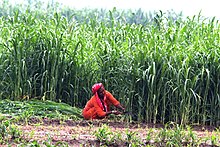Fodder
This article needs additional citations for verification. (October 2014) |

Fodder (
The worldwide

Common plants specifically grown for fodder



- Alfalfa (lucerne)
- Barley
- Common duckweed[2]
- Birdsfoot trefoil
- Brassica spp.
- Clover
- Alsike clover
- Red clover
- Subterranean clover
- White clover
- Grass
- Bermuda grass
- Brome
- False oat grass
- Fescue
- Heath grass
- Meadow grasses (from naturally mixed grassland swards)
- Orchard grass
- Ryegrass
- Timothy-grass
- Corn (maize)
- Millet
- Oats
- Sorghum
- Soybeans
- Trees (pollard tree shoots for "tree-hay")
- Wheat


Types
- Biochar for cattle[3]
- Bran
- Conserved forage plants: hay and silage
- Compound feed and premixes, often called pellets, nuts or (cattle) cake
- Crop residues: stover, copra, straw, chaff, sugar beet waste
- Fish meal
- Freshly cut grassand other forage plants
- Grass or lawn clipping waste[4]
- Green maize
- Green sorghum
- Horse gram
- Leaves from certain species of trees[5]
- Meat and bone meal (now illegal in cattle and sheep feeds in many areas due to risk of BSE)
- Molasses
- Native green grass
- Oilseed press cake (sunflower, soybean, peanut or groundnut)
- Oligosaccharides
- Processed insects (i.e. processed maggots[6])
- Seaweed (including Asparagopsis taxiformis which is used mainly as a supplement to reduce methane emissions by up to 90%)
- Seeds and grains, either whole or prepared by crushing, milling, etc.
- can also be made from atmospheric CO2)
- Sprouted grains and legumes
- Yeast extract (brewer's yeast residue)
Health concerns
In the past,
Droughts


Increasing intensities and frequencies of drought events put rangeland agriculture under pressure in semi-arid and arid geographic areas. Innovative emergency fodder production concepts have been reported, such as bush-based animal fodder production in Namibia. During extended dry periods, some farmers have used woody biomass fibre from encroacher bush as their primary source of cattle feed, adding locally-available supplements for nutrients as well as to improve palatability.[8][9][10][11]
Production of sprouted grains as fodder
This section may be confusing or unclear to readers. (July 2021) |

Fodder in the form of sprouted
can be grown in small and large quantities.Systems have been developed recently[when?] that allow for many tons of sprouts to be produced each day, year round. Sprouted grains can significantly increase the nutritional value of the grain compared with feeding the ungerminated grain to stock.[12] In addition, they use less water than traditional forage, making them ideal for drought conditions. Sprouted barley and other cereal grains can be grown hydroponically in a carefully-controlled environment.[13] Hydroponically-grown sprouted fodder at 150 mm tall with a 50 mm root mat is at its peak for animal feed.
Although products such as barley are grain, when sprouted they are approved by the American Grassfed Association to be used as livestock feed.[citation needed]
See also
- Cannon fodder (metaphorical usage)
- Circular agriculture
- Factory farming
- Feed manufacturing
- Food-feed system
- Pasture
References
- ^ "Global Feed Statistics". International Feed Industry Federation. Retrieved 18 March 2024.
- ^ Devlamynck, Reindert; Meers, Erik (May 2018). "Valorization of agricultural wastewater streams into an alternative protein source duckweed".
- ^ Daly, Jon (18 October 2019). "Poo-eating beetles and charcoal used by WA farmer to combat climate change". ABC.net.au. Australian Broadcasting Corporation.
Mr Pow said his innovative farming system could help livestock producers become more profitable while helping to address the impact of climate change.
- ISBN 0-8040-1069-2.
- ^ "Fodder trees for more milk and income" (PDF). Department for International Development. Archived from the original (PDF) on 2015-09-27. Retrieved 2015-09-22.
- ^ Medeiros, João (9 March 2014). "How AgriProtein makes chicken food from maggots". Wired.
- PMID 3292921.
- ISBN 978-981-99-2427-1, retrieved 2023-07-13
- ^ "Report on the Bush-to-Feed Pilot Projet in the African Wild Dog Community Forest". Ministry of Agriculture, Water and Forestry. 2018.
- ^ Matthys, Donald (2018-11-30). "Manual on how to produce animal feed from local encroached bush launched". Namibia Economist.
- ^ "Turning bush to feed in face of drought". The Namibian. 2016-10-18. Archived from the original on 2020-06-25. Retrieved 2020-06-22.
- ISBN 1740365038. Retrieved 7 June 2018.
- ISBN 1740365038. Retrieved 7 June 2018.
Hydroponic sprouts may have profitable application in intensive, small-scale livestock situations with high value outputs, where land and alternative feed costs are high, and where the quality changes (eg less starch, more lysine, vitamins, etc) due to sprouting are advantageous to the particular livestock.
Further reading
- Zhou, Yiqin. Compar[ison of] Fresh or Ensiled Fodders (e.g., Grass, Legume, Corn) on the Production of Greenhouse Gases Following Enteric Fermentation in Beef Cattle. Rouyn-Noranda, Qué.: Université du Québec en Abitibi-Témiscamingue, 2011. N.B.: Research report.
- Google books.
External links
- UK Food Standards Agency, Animal feed legislation and guidance Archived 2010-12-13 at the Wayback Machine
- FAO Feed Safety guidelines Archived 2010-12-02 at the Wayback Machine
